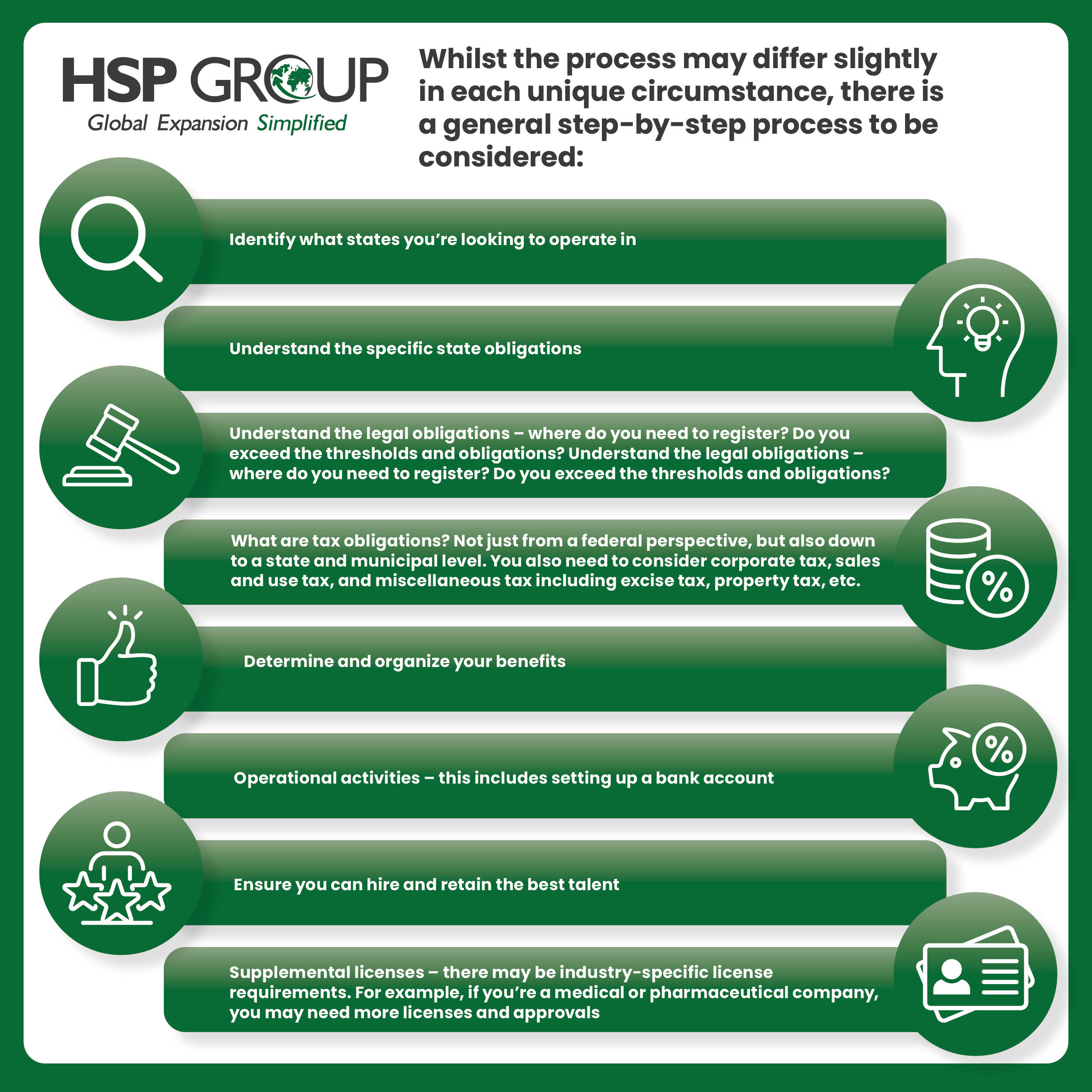For businesses looking to expand to the USA, there is enormous potential for growth and access to a large talent pool that can help your business to thrive.
No global market holds more sway over entrepreneurs than the United States. As the largest economy in the world, it presents unmatched opportunities for growing businesses.
To help you on your journey, our expansion experts have outlined some key considerations when developing your US expansion strategy.
What are the challenges of expanding into the USA?
With 50 states come various laws and regulations, posing a significant challenge for employers – especially those based abroad.
Navigating through varying legislation at both federal and state levels involves considerations such as income, sales, and use tax laws. Additionally, companies must address expectations and costs related to employer-provided healthcare and other supplemental benefits. This also includes dealing with federal IRS matters versus those of varying state departments of revenue, as well as ensuring compliance with the Department of Labor (DOL), worker’s compensation, The Affordable Care Act, Dependent Care, and 401k. The list is overwhelming and a little intimidating, especially for those who are new to global expansion.
Other expansion challenges facing businesses include:
- Market saturation. The US market is highly competitive, and breaking through the noise of established companies can be challenging.
- Customer acquisition and marketing. Unless you already have a customer base established, it can be difficult, and sometimes costly, to acquire them.
- Talent acquisition. Hiring and retaining talent can pose challenges, especially if you’re a smaller business. You also need to consider local labor markets and cultural fits – something we delve into further down in the blog.
- Funding and financial considerations. You need to make sure you have the correct financial resources to fund your expansion, as well as the facilities to manage cash flow and understand tax compliance.
With all these factors in mind, having trusted experts to help shape your strategy for long-term success is essential.
What are the benefits of expanding into and doing business in the USA?
Of course, despite challenges, expansion into the US comes with a whole host of benefits that make the process worthwhile.
For one, America boasts one of the world’s biggest economies, providing unlimited market expansion and growth potential, perfect for a business eager to evolve in a thriving market.
The real driver? The US provides businesses with access to phenomenal talent, helping them grow and expand.
It’s fiercely competitive, wonderfully dynamic, and opens a world of opportunity like no other – If you can make it in the US, you can make it anywhere.
Do you need a physical entity to operate in the USA?
Choosing the appropriate business entity is crucial. Remember, the simplest setup may not be the most cost-effective in the long term. While establishing a branch office might initially seem like a quick way to get started in the United States, it can have significant implications.
A branch office is an extension of the parent company rather than a separate legal entity. In these cases, you’ll not only be subject to US taxes on your entire corporate income but also expose your existing business to potential liabilities and lawsuits.
Considering this scenario, most companies prefer setting up a subsidiary company. This serves as a distinct legal entity that provides protection to the parent company. It also allows for separate treatment of liabilities, taxation, and regulations if compliance is maintained.
The limited liability company (LLC) and the business corporation are the two most common entity types in the United States. While deliberating on the most suitable entity for your goals, it’s important to remember that advice applicable to US residents may not necessarily apply to non-US residents.
As a foreign national starting a business, special considerations affect several areas. These include tax rates, employee benefits, paperwork requirements, exit strategies, funding opportunities, ownership transfers, and more.

What employment structures exist?
Employment structures in the USA are also different. It is not uncommon for companies to “outsource” the HR administration (payroll, employee benefits) to a third party, producing what are known as “co-employment” arrangements.
For example, you can begin business in America without needing a physical entity, instead using Employer of Record (EoR) solutions.
EoR is a quick-to-market, mitigated risk solution that essentially removes any liability from the employer, taking care of anything from payroll management, legal compliance, tax, benefits administration, HR support, and local representation.
As your business grows and scales, you may look to graduate from the initial EoR solution to a Professional Employer Organization (PEO).
This approach involves three parties in an employment relationship: the employee, the main company, and a third-party PEO firm that handles payroll administration and employment benefits.
These employment structures have gained popularity due to the following factors:
- The intricate nature of employment laws in multiple states necessitates specialized knowledge of state-specific regulations.
- The substantial costs associated with providing employee benefits, especially medical insurance.
- The ability to minimize the need for a large in-house HR department by leveraging economies of scale across employers.
Why are employee benefits so complex in the USA?
Another reason EoR and PEO have become so popular when expanding to the US is because employee benefits are incredibly complex. A web of federal, state, and local laws and regulations governs employee benefits. This includes requirements surrounding healthcare, retirement plans, and paid leave.
Specifically, the US healthcare system is renowned for its complexity and costs – managing insurance options such as plan selection and cost-sharing, along with compliance with healthcare laws, can be challenging for employers.
If you’re an employer in the US, though it may not be mandatory (as a small business) to provide employees with basic supplemental healthcare, such as eye care and dental care, most individuals in the US will often expect that the company will offer some sort of supplemental healthcare plan.
Another point of complexity is the expense of healthcare. There is a bare minimum list of basic supplemental health policies that all employers need, but small employers going out to market will find sourcing these benefit plans to be cost-prohibitive.
EoR and PEO make it easier to manage employee benefits
Typically, to deal with this most effectively, businesses will outsource payroll and employee benefits to either an EoR or PEO provider.
As mentioned above, both EoR and PEO solutions exist to remove this layer of complexity, relieving employers of the administrative burden, providing cost-efficient benefit plans that your company may not have been able to source as a stand-alone employer and instead, providing businesses with a solution that takes care of the administration of employee benefits for them.
HSP can help you transition from EoR to PEO without disruption to your healthcare plan, so you can confidently opt for either of these solutions to simplify the world of administrating benefits in the US.
A checklist for US expansion
While the process may differ for each company, there is a general step-by-step process to be considered:
1. Identify what states you’re looking to operate in and what activities you plan to carry out in each state (i.e., hiring employees, warehousing, sales, etc.)
2. Understand the specific state obligations and registrations for conducting business. Where do you need to register? Do you exceed the thresholds and obligations? If registered, what are your ongoing legal obligations?
3. What are tax obligations, and are there any tax incentives that may apply to your company? Not just from a federal perspective but also from the state and municipal levels. You also need to consider corporate tax, sales and use tax, and miscellaneous tax, including excise tax, property tax, etc.
4. Determine and organize your payroll & benefits strategy – what do you plan to offer, and what payroll option works best for your company?
5. Have you completed all supplemental tasks to be “operationally ready” – setup of a bank account, obtaining industry-specific licenses (for example, if you’re a medical or pharmaceutical company, you may need more licenses and approvals), etc?
6. Ensure you can recruit, hire, and retain the best talent.
How can HSP help with expanding into the USA?
With its team of expansion experts, HSP is perfectly placed to help businesses expand into the USA.
Our solutions are designed to make it easy for you to set up your business activity in the US. Let’s say you’ve found some incredible talent within the US market that you need to hire. We can make it happen within a month through our EoR and PEO solutions. Do you need to grow your payroll and back-office operations? We can do this too.
No other vendor does what we do in the US – we’re proud to be a ‘one-stop-shop,’ a single provider that can do anything from legal entity management and corporation, EoR, PEO, and payroll services to accounting and tax compliance.
We also provide a consultative element – when you engage with HSP for your US expansion, you get that extra layer of service with a dedicated consultant by your side. They will assist you with answering all your questions and advising you on how to successfully complete your expansion checklist in a compliant and efficient manner.
Ready to enter the US?
Get in touch with the team at HSP Group today to discuss your US expansion journey and learn more about how we can help you with what will inevitably be an exciting opportunity for your business.






